
| Celeb Tattoos | Facts & Stats | Designs & Symbols | History | Culture | Links | Tattoo Galleries | Contact |
PIERCING AND PENETRATION: BODY ARTS OF THE UNANGAN, ALUTIIQ, AND CHUGACH OF ALASKABy Lars Krutak
Despite the fact that it has been over 250 years since Steller's observation, not one significant study focusing upon the traditional body piercing of the Aleuts exists. This seems strange because nowhere else in the world can we find such a long and detailed record of piercing art representing spiritual beliefs and hunting practices across such a vast and little-known region. For the inhabitants of these windswept islands, labrets, piercings, and tattoos were symbolically tied to the most sacred realms of cultural experience. Body art was created not only to lure, please, and honor the spirits of animals; it also increased the social status, spiritual power, and beauty of the adorned. History of Piercing in the Aleutian Archipelago and BeyondStretching 1,500 miles from Kamchatka, Russia to the Alaska Peninsula, the Aleutian archipelago has been inhabited for about 7000 years. Traditionally, the term "Aleut" was used by Russian fur-traders to describe the indigenous peoples they met. Today, the Unangan (who speak the Aleut language), Alutiiq (Kodiak Islanders), and the Chugach of Prince William Sound see themselves as distinct from one another culturally and linguistically and designate themselves accordingly. With the invasion of the Russians in the 18th century, each group was gradually enslaved and organized into a force to labor for the Russian fur-based empire. Besides the dramatic decline in populations due to the introduction of foreign diseases, the indigenous cultures were disrupted to the point where many traditional practices almost disappeared by the time of the American occupations in the mid-19th century. Whether fueled by the Russian distaste of the "hideous" customs of tattoo and piercing or the Christian missionary's efforts to eradicate aspects of dress, grooming, and ritual they found "deplorable" and "savage," body piercing, labrets and tattoos were rarely seen after 1820. Nosepins
Ear Ornaments
Labrets
Biological Dimensions Obviously, these practices signalled a very important life event - permanent incorporation into a well-defined "marked" group of mature adults. Bodily modification was a visual cue by which individuals could evaluate one another, especially if placed on the face. This was particularly important in cultures where disease and pathogen prevalence was high, since those individuals who survived these painful and infective procedures attracted more husbands and wives. In a study of 186 societies that practiced polygamy, like the traditional Aleut, Low found that men who scarified themselves were likely to acquire more than one wife. Ludvico and Kurland concluded in a 1995 study that tattooing had the same effect, "because such women are assumed to be more willing to endure pain to please their lover and to cope successfully with the pain of childbirth." Of course, it has also been shown that in areas of the world where resources are limited deceiving another individual, or even deceiving oneself by altering your personal appearance, could serve to heighten an individual's perceived self-confidence and self-esteem, and duly impress his or her competitors. Symbolic DimensionsBecause the Aleut used a variety of materials in plugging their orifices, it can be assumed that particular labrets, noserings, and earrings were worn at particular times or during specific rituals. Langsdorff stated that the Unalaska Islanders, "on solemn occasions, dances, and festivals, they fasten strings of glass beads to the ends of pieces of wood" bored into the nostrils. Levashev, who visited Unalaska in 1769, noted a similar observation although "on gala occasions and more often in war they hang between the inserted 'teeth' of the lip beads and amber." As noted, many of the ornaments worn by the Aleut were made from the bone, ivory, and whiskers of specific animals: most notably eagles, walrus, and sea lions. The concept of transformation - men and women into animals, animals into men, and animals into animals - permeated all aspects of life among traditional Aleut cultures. Eagles were creatures linked to the sun and their beaks not only represented the power of predation and killing but also stood for the male procreative power. Their feathers and bones were used for ceremonial and magical purposes and protected the dead on their journey to the afterlife. The speed, cunning, and accuracy of these birds were emulated by Aleut hunters who with their beak-like hunting visor, decorated with carved ivory "wings" and a "tail" of sea lion whiskers, became transformed into a powerful bird of prey. The hunter's harpoon magically became a talon and bore sculptural forms of a toothy and fanged wolf-like creature that assisted in capturing game. Ivory labrets mimicked the white spots at each side of a killer whale's mouth or of the tusks of the walrus - a dangerous adversary who sometimes ate humans. Because nosepins, earrings, and labrets were significant visual symbols tied to some of the most sacred realms of cultural experience, it is possible they were perceived as having medicinal values as well. The Aleut believed that a manipulatable power resided in the body that persisted in the dead through mummification. In life, this power was regulated at crucial periods, mainly through joint-binding with sinew cords. Joint-binding was practiced when a young girl had reached her menses or when a husband or wife died. Of course, the Aleut also dismembered enemies and dangerous persons at their joints as a way of protecting the living from the evil dead. The practice even extended to honoured birds, such as the hawk and owl. It is likely, then, since the Aleut also practiced forms of medicine similar to Chinese acupuncture, that they had some conception of the yin/yang cosmology and attempted to regulate "good" and "bad" energies through the plugging of orifices. Joints and body openings were the "highways" which evil entities traveled to penetrate the human body and harm it, since in many circumpolar cultures these areas were considered to be the seats of the soul(s). On St. Lawrence Island, among other places in the Arctic, tattoo was utilized to close down these passageways. To this end, it would not be surprising if the Aleut had a similar concept in regards to body piercing. Grant Keddie stated that "the labret may demonstrate one's spiritual mastery over bodily entrances from which spirits enter and exit and therefore by analogy one's power over the forces of nature." The Universal BodyAleut adornment not only satisfied the need for personal expression, the social need for display, celebration, and accomplishment; it worked as a vehicle that carried the lineage into the future. But it also embodied religious beliefs about the relationship between humans, animals, and the deities that controlled human destiny and the surrounding world. Noserings, labrets, and tattoos were natural symbols simultaneously linking nature, society, and culture into one aspect. Body piercing justified human existence by not only influencing the supernatural and the dead, but by influencing the wishes and actions of other living individuals in the community itself. Thus, the Aleut body should not only be understood as a vastly complex and natural machine, but also as a body-landscape that mapped particular features of the Aleut ritual universe on the human skin. LiteratureBlack, L.T. 1991. "The Hunter's Dress as Metaphor of Power." Proceedings of the 5th International Abashiri Symposium: Hunting Rituals of Northern Peoples: 63-67. Cook, J. & King, J. 1784. A Voyage to the Pacific Ocean Undertaken, by the Command of His Majesty, for Making Discoveries in the Northern Hemisphere. Performed Under the Direction of Captains Cook, Clarke, and Gore, in His Majesty's Ships the Resolutions and Discovery; in the Years 1776, 1777, 1778, 1779, and 1780. 3 vols. London: G. Nicol and T. Cadell. Coxe, W. 1803. Account of the Russian Discoveries Between Asia and America to Which Are Added, the Conquest of Siberia and the History of the Transactions and Commerce Between Russia and China. 4th enl. ed. London: Cadell and Davies. Davydov, G.I. 1810-12. Dvukratnoe puteshestvie v Ameriku morskikh ofitserov Khvostova I Davydova, pisannoe sim posliednim [A Double Voyage to America by the Naval Officers Khvostov and Davydov, Written by the Latter]. St. Petersburg: Morshaia Tipografiia. Hrdlicka, A. 1945. The Aleutian and Commander Islands and Their Inhabitants. Philadelphia: The Wistar Institute of Anatomy and Biology. Keddie, G. 1989. "Symbolism and Context: The World History of the Labret and Cultural Diffusion on the Pacific Rim." Unpublished paper presented at the Circum-Pacific Prehistory Conference, Seattle. Krutak, L. 1999. "Im Zeichen des Wals" Tätowier Magazin 39: 52-56. Mai. Langsdorff, G.H. von. 1813-14. Voyages and Travels in Various Parts of the World During the Years 1803, 1804, 1805, 1806, and 1807. 2 vols. London: H. Colburn. Lisiansky, U. 1814. A Voyage Round the World in the Years 1803, 4, 5, & 6: Performed by Order of His Imperial Majesty Alexander the First, Emperor of Russia, in the Ship Neva. London: Printed for J. Booth. Ludvico L.R. & Kurland, J.A. 1995. "Symbolic of Not-So-Symbolic Wounds: The Behavioral Ecology of Human Scarification." Ethology and Sociobiology 16: 155-172. Sarychev, G. A. 1806-07. Account of a Voyage of Discovery to the North-east of Siberia, the Frozen Ocean, and the North-east Sea. 2 vols. London: Printed for R. Phillips by J.G. Barnard. Singh, D. & Bronstad, P.M. 1997. "Sex Differences in the Anatomical Locations of Human Body Scarification and Tattooing as a Function of Pathogen Prevalence." Evolution and Human Behavior 18: 403-416. |
||
| Celeb Tattoos | Facts & Stats | Designs & Symbols | History | Culture | Links | Tattoo Galleries | Contact | |||
Back to BERING SEAOther tattoo articles by Lars Krutak
© 2001-2010 Lars Krutak |
|||
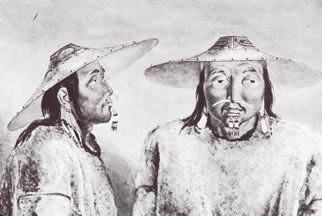 In
1741, the German-born Georg Wilhelm Steller became the first European to
describe the Native peoples of Alaska - Unangan or Aleuts on the
Shumagin Islands: "One man had a piece of bone three inches long
struck through crosswise above the chin just under the lower lip. Still
another had a bone like it fastened in the forehead, and another,
finally, had a similar one in each of the wings of the nose." Steller,
a physician and naturalist on Vitus Bering's 2nd expedition to Alaska,
made numerous ethnographic and scientific discoveries on this voyage,
but his life was cut short when he died of a sudden illness at the age
of 37.
In
1741, the German-born Georg Wilhelm Steller became the first European to
describe the Native peoples of Alaska - Unangan or Aleuts on the
Shumagin Islands: "One man had a piece of bone three inches long
struck through crosswise above the chin just under the lower lip. Still
another had a bone like it fastened in the forehead, and another,
finally, had a similar one in each of the wings of the nose." Steller,
a physician and naturalist on Vitus Bering's 2nd expedition to Alaska,
made numerous ethnographic and scientific discoveries on this voyage,
but his life was cut short when he died of a sudden illness at the age
of 37.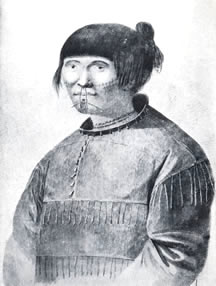 Nosepins
were worn by all indigenous groups, by both sexes, with the incision being
pierced shortly after birth. The ornament might be an eagle's feather
shaft, a sea lion whisker, piece of bark, bone, or a leather thong with
dentalium shells worn horizontally through the nose. Sometimes, women
strung various beads of coral and amber on the nosepin and let them hang
down to the tips of their chins. Both dentalium and amber were highly
prized by men and women as they could only be obtained from other groups
living to the east and south of Aleut territory. Urey Lisiansky stated
in 1814 that "amber is held in as high estimation as diamonds in
Europe." On Kodiak Island, a pair of dentalia was worth "an entire
squirrel-skin parka" whereas "one pair of amber ornaments was worth
two sea-otter skins ($90-100 a skin)" to the Chugach. It is
interesting to note that some of the dentalium obtained by the Aleut
came from the vicinity of the Queen Charlotte Islands where natives, "by
immersing in the water the body of someone who has died, or of a slave
killed specially for the purpose," removed the worms clinging to the
deceased and gathered their shells which the Aleut called tsuklei.
Nosepins
were worn by all indigenous groups, by both sexes, with the incision being
pierced shortly after birth. The ornament might be an eagle's feather
shaft, a sea lion whisker, piece of bark, bone, or a leather thong with
dentalium shells worn horizontally through the nose. Sometimes, women
strung various beads of coral and amber on the nosepin and let them hang
down to the tips of their chins. Both dentalium and amber were highly
prized by men and women as they could only be obtained from other groups
living to the east and south of Aleut territory. Urey Lisiansky stated
in 1814 that "amber is held in as high estimation as diamonds in
Europe." On Kodiak Island, a pair of dentalia was worth "an entire
squirrel-skin parka" whereas "one pair of amber ornaments was worth
two sea-otter skins ($90-100 a skin)" to the Chugach. It is
interesting to note that some of the dentalium obtained by the Aleut
came from the vicinity of the Queen Charlotte Islands where natives, "by
immersing in the water the body of someone who has died, or of a slave
killed specially for the purpose," removed the worms clinging to the
deceased and gathered their shells which the Aleut called tsuklei.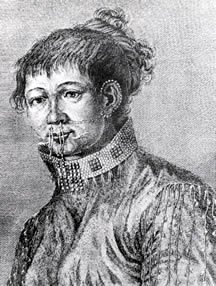 Ear
ornaments were another common form of adornment. Coxe stated in 1803
that the Unangan Fox Islanders "wore bones thrust through the ears."
Oftentimes, there were holes all around the rim of the ear with
dentalium shells, beads of shell, bone, and amber placed in each
orifice. An Unangan Attu Islander, before she was given to her husband
in marriage, had ten sea lion whiskers pierced into each ear. Sea lion
whiskers were considered to be very valuable because they were regarded
as trophies that indicated a good hunter, or the wife of a good hunter,
since each animal has only four whiskers and "any number of them
together must be a testimony of having captured a great many." These
whiskers also adorned the wooden hunting gear of Aleut men. A visitor to
the Andreanov Islands in 1761 noted, "instead of earrings put into
their ears the women wear eagles' and geese feathers behind the ears."
In the Kagamil Island burial caves, Ales Hrdlicka found numerous bird
skulls, bones, the skins of hawks, dried bird wings buried with the
mummies of children and even a bird feather "still stuck in the ear of
one of the mummified heads." No doubt, certain birds were seen as
protective animals in the afterlife and not surprisingly the Kodiak
Islanders raised eagles as pets, using their feathers in ritual
festivals to honor the sun.
Ear
ornaments were another common form of adornment. Coxe stated in 1803
that the Unangan Fox Islanders "wore bones thrust through the ears."
Oftentimes, there were holes all around the rim of the ear with
dentalium shells, beads of shell, bone, and amber placed in each
orifice. An Unangan Attu Islander, before she was given to her husband
in marriage, had ten sea lion whiskers pierced into each ear. Sea lion
whiskers were considered to be very valuable because they were regarded
as trophies that indicated a good hunter, or the wife of a good hunter,
since each animal has only four whiskers and "any number of them
together must be a testimony of having captured a great many." These
whiskers also adorned the wooden hunting gear of Aleut men. A visitor to
the Andreanov Islands in 1761 noted, "instead of earrings put into
their ears the women wear eagles' and geese feathers behind the ears."
In the Kagamil Island burial caves, Ales Hrdlicka found numerous bird
skulls, bones, the skins of hawks, dried bird wings buried with the
mummies of children and even a bird feather "still stuck in the ear of
one of the mummified heads." No doubt, certain birds were seen as
protective animals in the afterlife and not surprisingly the Kodiak
Islanders raised eagles as pets, using their feathers in ritual
festivals to honor the sun.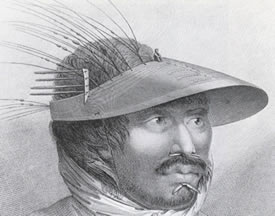
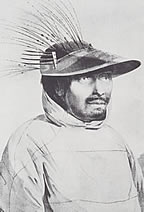 When
Russians first made contact with the peoples of the Aleutian
archipelago, the one custom that
intrigued them the most was the insertion of various types of labrets
into the lower lip and cheek. Captain Cook noted in the 1770s "what
the men have thrust thro the hole in the underlip has the resemblance of
2 Boars tusk, and are 2 pieces of bone about 1 ½ Inch long joining in
the middle of the lip, & separating, by means of the tongue
they can move these bones, & make
them point up and down. Others have a single polished bone the shape and
size of a large
When
Russians first made contact with the peoples of the Aleutian
archipelago, the one custom that
intrigued them the most was the insertion of various types of labrets
into the lower lip and cheek. Captain Cook noted in the 1770s "what
the men have thrust thro the hole in the underlip has the resemblance of
2 Boars tusk, and are 2 pieces of bone about 1 ½ Inch long joining in
the middle of the lip, & separating, by means of the tongue
they can move these bones, & make
them point up and down. Others have a single polished bone the shape and
size of a large
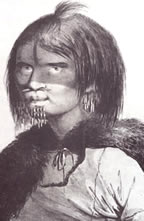 Stud." In 1802, Gavrila Davydov said that Kodiak
Island women made "several holes in their lower lip from which they
hang a loop into which are placed beads and small white bones. These
holes vary in number between two and six. Their lips are pierced by
close relatives and there is a great deal of respect, therefore, for the
girl islander who has the most." Although labrets of this type were
usually worn for decorative purposes, they also signified the social
status, prestige, and age of the wearer. Women of Prince William Sound
ornamented their lips in this manner as well.
Stud." In 1802, Gavrila Davydov said that Kodiak
Island women made "several holes in their lower lip from which they
hang a loop into which are placed beads and small white bones. These
holes vary in number between two and six. Their lips are pierced by
close relatives and there is a great deal of respect, therefore, for the
girl islander who has the most." Although labrets of this type were
usually worn for decorative purposes, they also signified the social
status, prestige, and age of the wearer. Women of Prince William Sound
ornamented their lips in this manner as well.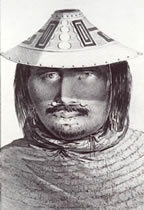 Men
perforated the lip by placing several studs of walrus ivory into
separate holes that appeared to Captain Cook as representing "another
row of teeth immediately under their own".
This style of labretifery was common on the Turnagain River and on
Kodiak Island where "men wear up to ten garnets - white in back,
blue in front - underneath their lower lip." Interestingly, some men
of the Aleutian archipelago were "brought up entirely in the manner of
girls, and instructed in all the arts women use to please
Men
perforated the lip by placing several studs of walrus ivory into
separate holes that appeared to Captain Cook as representing "another
row of teeth immediately under their own".
This style of labretifery was common on the Turnagain River and on
Kodiak Island where "men wear up to ten garnets - white in back,
blue in front - underneath their lower lip." Interestingly, some men
of the Aleutian archipelago were "brought up entirely in the manner of
girls, and instructed in all the arts women use to please 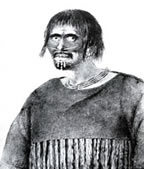 man: their
beards are carefully plucked out as soon as they begin to appear, and
their chins are tattooed like those of the women." Whether mothers and
fathers dreaded the loss of their sons in war or while hunting at sea,
several accounts describe transgendered individuals. On Kodiak
Island in 1790, Sarychev saw "among the arriving Kodiaks there was a
40 year-old,
ugly fellow, clad in woman's garb; his face was tattooed and there
were beads in his nose. This man played the role of a wife for a young
islander and did all the woman's work." Davydov stated that these
people were known as akhutshcik "and are mostly magicians" or
shamans.
man: their
beards are carefully plucked out as soon as they begin to appear, and
their chins are tattooed like those of the women." Whether mothers and
fathers dreaded the loss of their sons in war or while hunting at sea,
several accounts describe transgendered individuals. On Kodiak
Island in 1790, Sarychev saw "among the arriving Kodiaks there was a
40 year-old,
ugly fellow, clad in woman's garb; his face was tattooed and there
were beads in his nose. This man played the role of a wife for a young
islander and did all the woman's work." Davydov stated that these
people were known as akhutshcik "and are mostly magicians" or
shamans.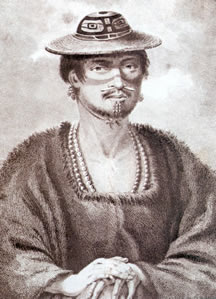 According to Lisiansky and others, the
piercing practices of the Aleut began in infancy: "incisions for the
single medial labrets were made in the lower lip 2 days after the birth
[with] the nasal septum also perforated at this time." Several medical
studies provide evidence that indigenous groups that stress or "harden"
their infants with piercing or scarification increase their children's
bodily development, viability and resistance to certain pathogens.
Landauer and Whiting showed that infants subjected to hardening
practices enhanced their resistance to stress and even grew taller than
those who did not receive such treatment. More recent studies agree with
this conclusion and suggest that many of the groups that harden their
infants also stress them when they reach puberty. For example, when an
Aleut woman experienced her first menses she received her first tattoo
and among some Inuit groups men received their first tattoos and labrets
after having killed their first animal.
According to Lisiansky and others, the
piercing practices of the Aleut began in infancy: "incisions for the
single medial labrets were made in the lower lip 2 days after the birth
[with] the nasal septum also perforated at this time." Several medical
studies provide evidence that indigenous groups that stress or "harden"
their infants with piercing or scarification increase their children's
bodily development, viability and resistance to certain pathogens.
Landauer and Whiting showed that infants subjected to hardening
practices enhanced their resistance to stress and even grew taller than
those who did not receive such treatment. More recent studies agree with
this conclusion and suggest that many of the groups that harden their
infants also stress them when they reach puberty. For example, when an
Aleut woman experienced her first menses she received her first tattoo
and among some Inuit groups men received their first tattoos and labrets
after having killed their first animal.